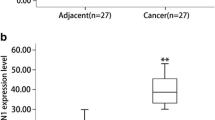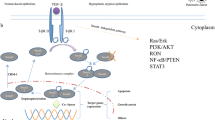Abstract
SHP2 is an src homology (SH) 2 domain-containing protein tyrosine phosphatase (PTP). SHP2 implicitly contributes to tumorigenesis, but the role of SHP2 in pancreatic ductal adenocarcinoma is still unknown. The purpose of this study was to evaluate the prognostic significance and associated expression of SHP2 in pancreatic ductal adenocarcinoma (PDAC) patients. We used immunohistochemistry to assess the protein expression levels of SHP2 in 79 PDAC specimens. The correlations between SHP2 expression and various clinicopathological features were evaluated by Pearson’s chi-square (χ 2) test, Fisher’s exact test, and Spearman’s rank. Univariate and multivariate Cox regression analyses were used to identify correlations between the immunohistochemical data for SHP2 expression and the clinicopathologic characteristics in PDAC. Kaplan-Meier survival analysis was used to demonstrate the relation between overall survival and the expression of SHP2. Immunohistochemistry revealed significantly higher rates of high SHP2 expression in PDAC tissues (55.7 %) versus adjacent non-cancer tissues (10.1 %) (P < 0.05). Expression of SHP2 was only significantly correlated with histological differentiation (P = 0.033) and vital status (P = 0.025). Patients with high SHP2 expression had shorter overall survival times compared to those with low SHP2 expression (P = 0.000). Multivariate Cox regression analysis revealed that SHP2 overexpression was an independent prognostic factor in PDAC (P = 0.012). Our study demonstrated for the first time that higher expression of SHP2 might be involved in the progression of pancreatic ductal adenocarcinoma, suggesting that SHP2 may be a potential prognostic marker and target for therapy.


Similar content being viewed by others
References
Jemal A, Siegel R, Xu J, Ward E. Cancer statistics, 2010. CA Cancer J Clin. 2010;60:277–300.
Gong Z, Holly EA, Bracci PM. Survival in population-based pancreatic cancer patients: San Francisco Bay area, 1995–1999. Am J Epidemiol. 2011;174:1373–81.
Vincent A, Herman J, Schulick R, Hruban RH, Goggins M. Pancreatic cancer. Lancet. 2011;378:607–20.
Katz MH, Wang H, Fleming JB, Sun CC, Hwang RF, Wolff RA, et al. Long-term survival after multidisciplinary management of resected pancreatic adenocarcinoma. Ann Surg Oncol. 2009;16:836–47.
He C, Jiang H, Geng S, Sheng H, Shen X, Zhang X, et al. Expression and prognostic value of c-Myc and Fas (CD95/APO1) in patients with pancreatic cancer. Int J Clin Exp Pathol. 2014;7:742–50.
Qu CK. Role of the SHP-2 tyrosine phosphatase in cytokine-induced signaling and cellular response. Biochim Biophys Acta. 2002;1592:297–301.
Freeman RJ, Plutzky J, Neel BG. Identification of a human src homology 2-containing protein-tyrosine-phosphatase: a putative homolog of Drosophila corkscrew. Proc Natl Acad Sci U S A. 1992;89:11239–43.
Ahmad S, Banville D, Zhao Z, Fischer EH, Shen SH. A widely expressed human protein-tyrosine phosphatase containing src homology 2 domains. Proc Natl Acad Sci U S A. 1993;90:2197–201.
Vogel W, Lammers R, Huang J, Ullrich A. Activation of a phosphotyrosine phosphatase by tyrosine phosphorylation. Science. 1993;259:1611–4.
Feng GS, Hui CC, Pawson T. SH2-containing phosphotyrosine phosphatase as a target of protein-tyrosine kinases. Science. 1993;259:1607–11.
Koch CA, Anderson D, Moran MF, Ellis C, Pawson T. SH2 and SH3 domains: elements that control interactions of cytoplasmic signaling proteins. Science. 1991;252:668–74.
Motiwala T, Jacob ST. Role of protein tyrosine phosphatases in cancer. Prog Nucleic Acid Res Mol Biol. 2006;81:297–329.
Hartman ZR, Schaller MD, Agazie YM. The tyrosine phosphatase SHP2 regulates focal adhesion kinase to promote EGF-induced lamellipodia persistence and cell migration. Mol Cancer Res. 2013;11:651–64.
Kandadi MR, Stratton MS, Ren J. The role of Src homology 2 containing protein tyrosine phosphatase 2 in vascular smooth muscle cell migration and proliferation. Acta Pharmacol Sin. 2010;31:1277–83.
Noguchi T, Matozaki T, Horita K, Fujioka Y, Kasuga M. Role of SH-PTP2, a protein-tyrosine phosphatase with Src homology 2 domains, in insulin-stimulated Ras activation. Mol Cell Biol. 1994;14:6674–82.
Feng GS. Shp2-mediated molecular signaling in control of embryonic stem cell self-renewal and differentiation. Cell Res. 2007;17:37–41.
Selimoglu-Buet D, Gallais I, Denis N, Guillouf C, Moreau-Gachelin F. Oncogenic kit triggers Shp2/Erk1/2 pathway to down-regulate the pro-apoptotic protein Bim and to promote apoptosis resistance in leukemic cells. PLoS One. 2012;7:e49052.
Dong S, Li FQ, Zhang Q, Lv KZ, Yang HL, Gao Y, et al. Expression and clinical significance of SHP2 in gastric cancer. J Int Med Res. 2012;40:2083–9.
Chan RJ, Feng GS. PTPN11 is the first identified proto-oncogene that encodes a tyrosine phosphatase. Blood. 2007;109:862–7.
Ren Y, Chen Z, Chen L, Fang B, Win-Piazza H, Haura E, et al. Critical role of Shp2 in tumor growth involving regulation of c-Myc. Genes Cancer. 2010;1:994–1007.
Bentires-Alj M, Paez JG, David FS, Keilhack H, Halmos B, Naoki K, et al. Activating mutations of the noonan syndrome-associated SHP2/PTPN11 gene in human solid tumors and adult acute myelogenous leukemia. Cancer Res. 2004;64:8816–20.
Hu Z, Fang H, Wang X, Chen D, Chen Z, Wang S. Overexpression of SHP2 tyrosine phosphatase promotes the tumorigenesis of breast carcinoma. Oncol Rep. 2014;32:205–12.
Wang HC, Chiang WF, Huang HH, Shen YY, Chiang HC. Src-homology 2 domain-containing tyrosine phosphatase 2 promotes oral cancer invasion and metastasis. BMC Cancer. 2014;14:442.
He HY, Zheng J, Li Y, Heng WJ, Fang WG. SHP2 and MKP5 in P2Y purinergic receptor-mediated prostate cancer invasion. Zhonghua Bing Li Xue Za Zhi. 2005;34:288–92.
Zhan X, Dong H, Sun C, Liu L, Wang D, Wei Z. Expression and clinical significance of SHP2 in the tumor tissues of smokers with lung cancer. Zhongguo Fei Ai Za Zhi. 2010;13:877–81.
Leibowitz MS, Srivastava RM, Andrade FP, Egloff AM, Wang L, Seethala RR, et al. SHP2 is overexpressed and inhibits pSTAT1-mediated APM component expression, T-cell attracting chemokine secretion, and CTL recognition in head and neck cancer cells. Clin Cancer Res. 2013;19:798–808.
Bard-Chapeau EA, Li S, Ding J, Zhang SS, Zhu HH, Princen F, et al. Ptpn11/Shp2 acts as a tumor suppressor in hepatocellular carcinogenesis. Cancer Cell. 2011;19:629–39.
Nabinger SC, Chan RJ. Shp2 function in hematopoietic stem cell biology and leukemogenesis. Curr Opin Hematol. 2012;19:273–9.
Grosskopf S, Eckert C, Arkona C, Radetzki S, Bohm K, Heinemann U, et al. Selective inhibitors of the protein tyrosine phosphatase SHP2 block cellular motility and growth of cancer cells in vitro and in vivo. ChemMedChem. 2015;10:815–26.
Tempero MA, Arnoletti JP, Behrman S, Ben-Josef E, Benson AR, Berlin JD, et al. Pancreatic adenocarcinoma. J Natl Compr Cancer Netw. 2010;8:972–1017.
Zhang LJ, Wang KB, Liu LS, Chen LZ, Peng BG, Liang LJ, et al. Overexpression of GOLPH3 is associated with poor prognosis and clinical progression in pancreatic ductal adenocarcinoma. BMC Cancer. 2014;14:571.
Aceto N, Sausgruber N, Brinkhaus H, Gaidatzis D, Martiny-Baron G, Mazzarol G, et al. Tyrosine phosphatase SHP2 promotes breast cancer progression and maintains tumor-initiating cells via activation of key transcription factors and a positive feedback signaling loop. Nat Med. 2012;18:529–37.
Chan G, Kalaitzidis D, Neel BG. The tyrosine phosphatase Shp2 (PTPN11) in cancer. Cancer Metastasis Rev. 2008;27:179–92.
Muenst S, Obermann EC, Gao F, Oertli D, Viehl CT, Weber WP, et al. Src homology phosphotyrosyl phosphatase-2 expression is an independent negative prognostic factor in human breast cancer. Histopathology. 2013;63:74–82.
Mohi MG, Neel BG. The role of Shp2 (PTPN11) in cancer. Curr Opin Genet Dev. 2007;17:23–30.
Gomes EG, Connelly SF, Summy JM. Targeting the yin and the yang: combined inhibition of the tyrosine kinase c-Src and the tyrosine phosphatase SHP-2 disrupts pancreatic cancer signaling and biology in vitro and tumor formation in vivo. Pancreas. 2013;42:795–806.
Grossmann KS, Rosario M, Birchmeier C, Birchmeier W. The tyrosine phosphatase Shp2 in development and cancer. Adv Cancer Res. 2010;106:53–89.
Neel BG, Gu H, Pao L. The 'Shp'ing news: SH2 domain-containing tyrosine phosphatases in cell signaling. Trends Biochem Sci. 2003;28:284–93.
Rosario M, Birchmeier W. How to make tubes: signaling by the Met receptor tyrosine kinase. Trends Cell Biol. 2003;13:328–35.
Author information
Authors and Affiliations
Corresponding author
Ethics declarations
This study was approved by the Ethics Review Committee of the Fuzhou General Hospital of Nanjing Military Command, and each patient signed an informed consent form before enrollment into the study.
Conflicts of interest
None
Funding
This work was funded by grants from the National Natural Science Foundation of China (No. 81302067 and No. 81302164).
Additional information
Jiawei Zheng and Shanshan Huang contributed equally to this work.
Rights and permissions
About this article
Cite this article
Zheng, J., Huang, S., Huang, Y. et al. Expression and prognosis value of SHP2 in patients with pancreatic ductal adenocarcinoma. Tumor Biol. 37, 7853–7859 (2016). https://doi.org/10.1007/s13277-015-4675-5
Received:
Accepted:
Published:
Issue Date:
DOI: https://doi.org/10.1007/s13277-015-4675-5




